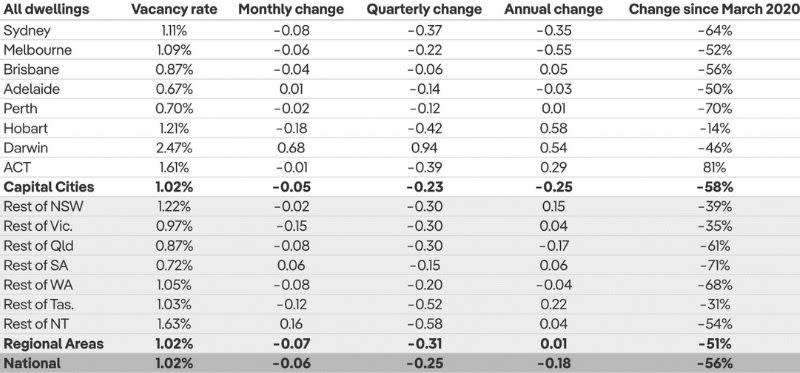
Limited supply and strong demand have driven Australia’s residential vacancy rate to a new record low of just 1.02 per cent, according to fresh data released this week.
The share of rental properties vacant and available is now 56 per cent lower than it was at the start of the pandemic, according to residential property market monitor PropTrack.
And the bad news for renters is the country’s strong population growth coupled with a critical shortage of new housing means the trend is likely to continue.
While not as dire at the previous month, October’s fall of 0.06 percentage points was enough to take national rental vacancies to a new low, with conditions deteriorating further in major cities along the eastern seaboard.
“Tenants faced even tougher conditions in October, with the proportion of rental properties sitting vacant falling to the lowest level on record,” PropTrack economist Anne Flaherty said.
“The national vacancy rate has been trending down for well over three years now—a trend that looks likely to continue off the back of strong population growth and a slowdown in the supply of new housing.
“Melbourne and Sydney have seen the sharpest falls in available rentals over the past 12 months, with vacancy down 0.55 percentage points and 0.35 percentage points, respectively,” Flaherty said.
Rental vacancy rates, October 2023 (percentage points)

Rental conditions in Sydney fell 0.08 percentage points in October to 1.11 per cent, while Melbourne vacancies slide 0.06 points to 1.09 per cent.
PropTrack said Brisbane and Perth’s rental vacancy rates continued to sit below 1 per cent.
The West Australian capital fell 0.02 points to 0.7 per cent. It has remained below 1 per cent for the past 15 months. Brisbane fell 0.04 points to 0.87 per cent.
At a rate of 0.67 per cent, Adelaide continues to have the lowest vacancy rate in the country.
Hobart’s was the sharpest drop, falling 0.18 points to 1.21 per cent, while Darwin was the only city with a significant rise, up 0.68 points to 2.47 per cent.
PropTrack reported conditions had also deteriorated in regional areas, with vacancies down 0.31 points over the quarter.